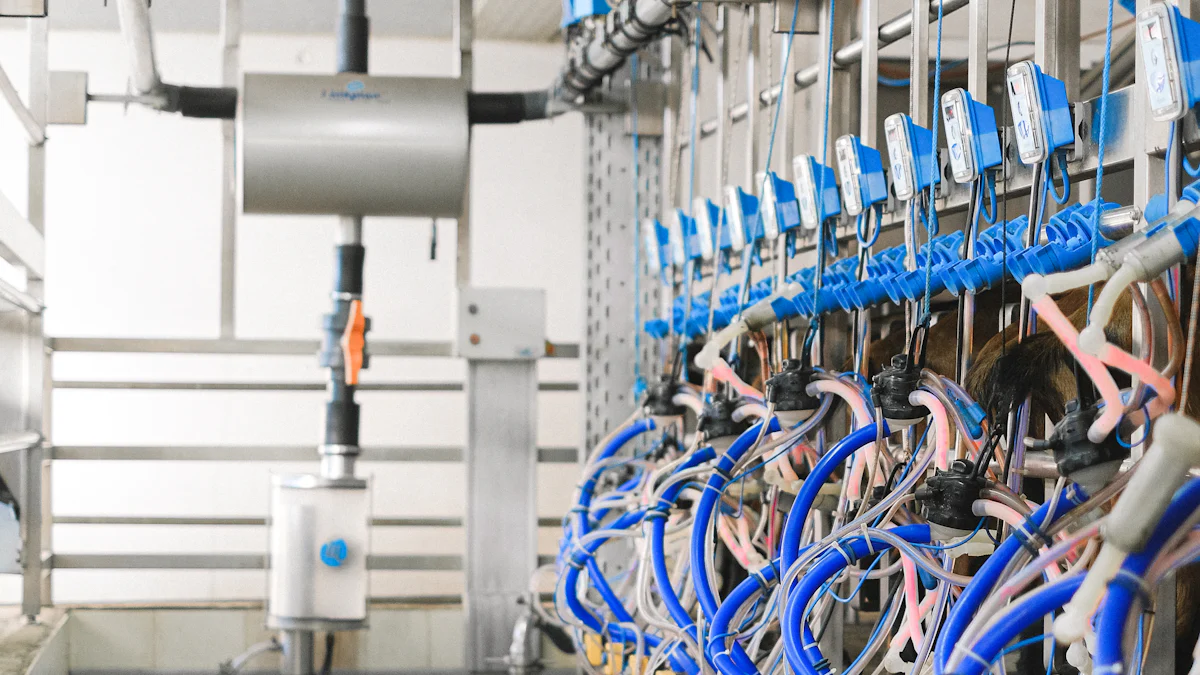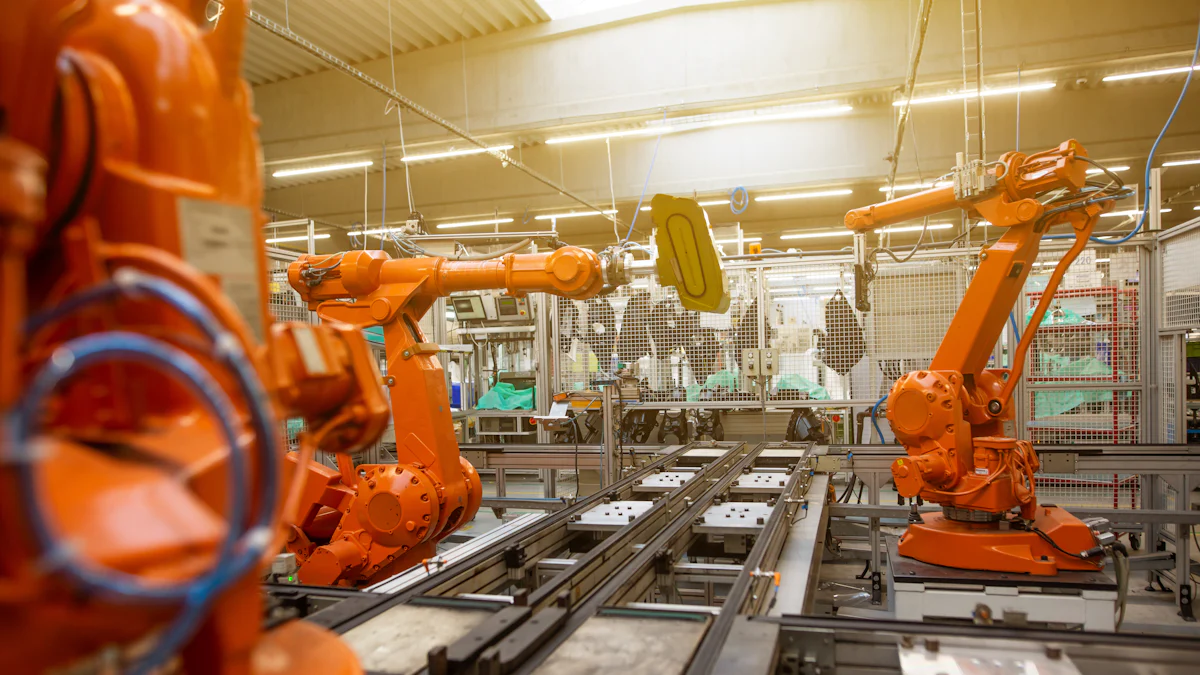
News

Imagine running an industrial operation where every motor works smarter, not harder. That’s what a frequency drive inverter does for you. By adjusting motor speed to match the actual load, it cuts energy waste and slashes costs. Plus, regenerative VFDs even capture energy during deceleration, boosting energy efficiency and sustainability in your processes.
Key Takeaways
Frequency drive inverters (VFDs) control motor speed and power. This saves energy and lowers operating costs for businesses.
VFDs improve work by reducing wear on motors. This means fewer repairs and better product results.
Using VFDs helps companies meet energy rules. It also supports eco-friendly goals and cuts harm to the environment.
Understanding Frequency Drive Inverters
What Are Frequency Drive Inverters?
A frequency drive inverter, often called a VFD, is a device that controls the speed and torque of electric motors. Think of it as the brain behind motor control in industrial systems. Instead of running motors at full speed all the time, it adjusts their speed to match what’s actually needed. This not only saves energy but also reduces wear and tear on your equipment.
You’ll find VFDs in almost every industry today. They’re used in everything from conveyor belts to HVAC systems. By fine-tuning motor performance, they help you achieve better precision and efficiency in your operations. Plus, they’re a key player in modern automation, making processes smarter and more adaptable.
How VFDs Work in Industrial Applications
So, how does a variable frequency drive work? It’s all about converting and controlling electricity. First, the VFD takes the incoming AC power and converts it into DC. Then, it uses a technique called Pulse Width Modulation (PWM) to create a new AC output. This output has a variable frequency and voltage, which lets you control the motor’s speed and torque.
Here’s the cool part: VFDs don’t just save energy. They also improve your workplace environment by reducing noise levels. By matching motor speed to process requirements, they minimize energy waste and even help you avoid costly peak-demand charges. And because they maintain the volts-per-hertz ratio, they ensure smooth motor operation without torque fluctuations. It’s like giving your motors a custom-fit suit for every task.
The Role of VFDs in Modern Industries

Motor Control and Precision
You know how important precision is in industrial automation. That’s where VFDs shine. These devices give you complete control over motor speed and torque by adjusting the frequency and voltage of the power supply. This level of motor control ensures your processes run smoothly and efficiently. Whether you’re handling delicate materials or running high-speed production lines, VFDs let you fine-tune operations to meet exact requirements.
What’s more, VFDs adapt quickly to changing demands. Need to switch speeds or adjust torque on the fly? No problem. This flexibility is a game-changer in industries where production lines often shift between different tasks. Plus, by reducing energy waste and optimizing performance, VFDs help you achieve operational efficiency without compromising on precision.
Enhancing Productivity and Product Quality
When your equipment runs smoothly, your productivity soars. VFDs make that happen by reducing mechanical stress on motors. They allow for smooth acceleration and deceleration, which minimizes wear and tear. This means fewer breakdowns and less downtime for maintenance.
But it’s not just about keeping things running. VFDs also improve product quality. By offering precise speed control, they ensure consistent performance across your processes. Whether you’re manufacturing goods or handling materials, this consistency translates to better results. And because VFDs support programmable operations, you can automate and fine-tune tasks for optimal efficiency.
Applications in Pumps, Fans, and Conveyors
Pumps, fans, and conveyors are the backbone of many industries, and VFDs make them even better. For pumps and fans, VFDs adjust motor speeds to match load demands. This reduces energy consumption and lowers your costs. Instead of relying on mechanical dampers or valves, you can achieve the same flow with less energy.
Conveyors benefit too. VFDs provide precise speed control, ensuring materials move at the right pace. This synchronization improves energy efficiency and keeps production rates steady. Whether you’re in manufacturing, food processing, or material handling, VFDs enhance both performance and longevity in these critical systems.
Energy Efficiency and Sustainability with VFDs

Reducing Energy Consumption
Energy efficiency is more than just a buzzword—it’s a necessity in modern industries. A frequency drive inverter helps you achieve this by controlling motor speed and torque. Instead of running motors at full capacity all the time, it adjusts their speed to match the actual demand. This simple adjustment can drastically cut energy waste. For example, variable frequency drives use pump and fan affinity laws to reduce motor speed, which significantly lowers power consumption while maintaining performance.
By using VFDs, you’re not just saving energy. You’re also reducing your electricity bills and avoiding costly peak-demand charges. This makes your operations leaner and more efficient, giving you a competitive edge in today’s energy-conscious world.
Supporting Sustainability Goals
If sustainability is part of your business strategy, VFDs are your ally. They optimize energy efficiency, which directly reduces your environmental footprint. By lowering energy use, they help cut greenhouse gas emissions and align your operations with global sustainability goals.
VFDs also comply with environmental standards, making it easier for you to meet regulatory requirements. Their regenerative capabilities even allow you to capture and reuse energy, further enhancing your sustainability efforts. Whether you’re scaling up or fine-tuning existing processes, VFDs make it possible to achieve your green objectives without compromising operational efficiency.
Cost Savings Through Optimized Energy Use
Let’s talk about savings. VFDs don’t just reduce energy consumption—they also lower operational costs. By adjusting motor speeds to match application needs, they prevent energy waste and reduce wear on equipment. This means fewer maintenance expenses and longer equipment lifespans.
Although the initial investment in VFDs might seem high, the energy savings quickly pay off. Many industries recoup their costs within a few years, thanks to lower electricity bills and reduced downtime. With VFDs, you’re not just investing in automation—you’re investing in long-term profitability.
Extending Equipment Lifespan and Process Control
Minimizing Mechanical Stress
You’ve probably seen how sudden starts and stops can wear out equipment over time. That’s where a frequency drive inverter steps in to save the day. It provides a controlled startup, gradually increasing motor speed instead of jolting it into action. This smooth acceleration reduces mechanical stress and prevents unnecessary strain on your equipment.
Traditional starters often cause high inrush currents, which can lead to overheating and excessive vibration. VFDs eliminate this issue by managing the power flow more effectively. They keep your motors running smoothly, protecting them from damage and extending their lifespan. With less wear and tear, your equipment stays in top shape for longer, giving you peace of mind and fewer headaches.
Improving Operational Precision
Precision is everything in automation, and VFDs deliver it in spades. By fine-tuning motor control, they allow you to adjust speed and torque with pinpoint accuracy. This means your processes can run exactly as needed, whether you’re handling delicate materials or operating heavy machinery.
Variable frequency drives also help you maintain consistent performance. They adapt quickly to changing demands, ensuring your operations stay efficient and reliable. With this level of control, you can optimize production, reduce errors, and improve overall product quality. It’s like having a precision tool for every task in your industrial setup.
Reducing Maintenance Costs and Downtime
Nobody likes unexpected breakdowns, right? VFDs help you avoid them by reducing the frequency of start-stop cycles. This minimizes wear on your equipment and keeps it running smoothly. They also prevent motor overloads, which can lead to overheating and costly repairs.
By lowering mechanical and electrical stress, VFDs reduce the chances of system failures. This means fewer maintenance interruptions and less downtime for your operations. Plus, their flexibility in adjusting motor speeds allows you to adapt quickly to process changes, keeping your production lines running efficiently. In the long run, you’ll save money and keep your operations hassle-free.
Regulatory and Safety Considerations for VFDs
Compliance with Energy Efficiency Standards
Staying compliant with energy efficiency standards is crucial when using frequency drive inverters. These regulations ensure your operations remain sustainable and cost-effective. For instance, the Ecodesign Regulation (EU) 2019/1781 has been in effect since July 2021. It mandates IE3 efficiency levels for motors ranging from 0.75 to 1,000 kW and includes three-phase standard drives from 0.12 kW to 1,000 kW. While some drives, like regenerative and low-harmonic types, are exempt, the push for higher efficiency continues. By July 2023, IE4 efficiency became mandatory for specific motor types, further tightening the requirements.
You can’t ignore these standards if you want to stay competitive. They not only reduce energy waste but also align your business with global sustainability goals. Plus, meeting these benchmarks helps you avoid penalties and ensures your automation systems operate at peak performance.
Meeting Safety Requirements
Safety is non-negotiable in industrial environments. Frequency drive inverters come equipped with features that prioritize it. For example, Safe Torque Off (STO) prevents motors from generating torque when needed, ensuring safe operation. Standards like EN 61800-5-2 define Safety Integrity Levels (SIL), which measure the reliability of safety functions in drive systems. Similarly, EN ISO 13849-1 outlines Performance Levels (PL) to assess machine control systems, including non-electrical components.
These safety features protect your equipment and workforce. They also simplify compliance with industry regulations, giving you peace of mind. Whether you’re upgrading existing systems or installing new ones, these built-in safeguards make VFDs a reliable choice.
Preparing for Future Regulations
Regulations evolve, and staying ahead of them is essential. Recent updates, like the Ecodesign Regulation (EU) 2019/1781, already impact low-voltage motors and variable speed drives. Here’s a quick look at what’s changing:
Preparing for these changes ensures your systems remain compliant and efficient. By adopting VFDs that meet or exceed current standards, you future-proof your operations and avoid costly upgrades later.
You can’t overlook the importance of frequency drive inverters in industrial automation. They save energy, improve productivity, and extend equipment lifespan. By reducing mechanical stress and adapting to changing demands, they ensure smooth operations. As regulations tighten, VFDs will remain essential for staying efficient, sustainable, and competitive in 2025 and beyond.
FAQ
What industries benefit the most from frequency drive inverters?
Industries like manufacturing, HVAC, water treatment, and food processing rely heavily on VFDs. They improve energy efficiency, enhance precision, and streamline automation processes.
Can VFDs work with older motor systems?
Yes, most VFDs are compatible with older motors. However, you should check the motor's specifications to ensure optimal performance and avoid potential issues.
Are VFDs difficult to maintain?
Not at all! Regular inspections and cleaning keep them running smoothly. Plus, their design minimizes wear and tear, reducing the need for frequent maintenance.
Please give us a message